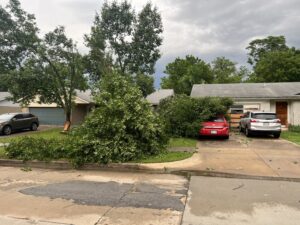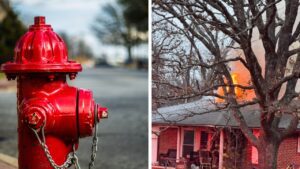With rounds of accumulating snow forecast to impact parts of the Sooner State over the next several days – late this week and early next week – AAA Oklahoma is urging drivers to be prepared for the conditions and to remain cautious if out on the roads, while the auto club’s roadside rescue fleet prepares for a busy period of assisting drivers.
AAA Oklahoma anticipates an increase in emergency roadside service calls as the wintry weather sweeps through and road conditions deteriorate, with slide-offs and crashes due to slick roads, battery/non-start problems and flat tires the main culprits. Last winter (Dec. 2022-March 2023), AAA Oklahoma Emergency Roadside Service crews assisted more than 58,000 motorists across the state.
More great winter-ready reading from Sapulpa Times:
- Creek County Master Gardner: Landscape preparations for winter
- Preparing your home for winter
- Winter safety tips
AAA Oklahoma tips to prepare vehicles for winter weather
Make certain your tires have good tread for adequate traction and are properly inflated. For every 10-degree drop in temperature, tires can lose 1 pound of air pressure.
Have the battery checked by a professional to ensure it is strong enough to face cold weather. When the air temperature is 32 degrees, a battery’s starting power drops 35 percent. Also, the average lifespan of a car battery is 3-5 years. winter battery.pngAAA members can request a visit from a AAA mobile battery service technician who will test their battery and replace it on-site, if necessary.
Keep your gas tank at least half-full to avoid gas line freeze-up.
Ensure that windshield wiper blades are in good condition and the wiper fluid reservoir is full. A winter blend of wiper fluid that resists freezing is recommended.
Make sure all lights (headlights, tail and brake lights, turn signals) are working properly so you can see and be seen in bad weather conditions.
Hazardous storms and inclement weather are a factor in an average of nearly half a million crashes and more than 2,200 traffic crash deaths nationwide every winter, according to the AAA Foundation for Traffic Safety. AAA Oklahoma is encouraging drivers to have safety in mind if they must venture out on the wintry roadways.
“Ice and snow can cause significant safety problems by reducing visibility and making it difficult to maneuver or stop,” said Rylie Fletcher, AAA Oklahoma spokesperson. “It’s important for drivers to be cautious and take it slow if they have to get out on the roads.”
On average, about one-third (32%) of crashes during the winter occur in adverse weather or road surface conditions, according to the AAA Foundation for Traffic Safety.
AAA Oklahoma tips for driving in snowy and icy conditions
Stay home. If you really don’t have to go out, don’t. Even if you can drive well in winter conditions, not everyone else can. Don’t tempt fate. Stay home until crews can properly clear roadways.
Check road conditions. Before you leave, assess the conditions of roads along your route.
Drive slowly. Everything takes longer on ice- and snow-covered roads. Accelerating, stopping, turning – give yourself time to maneuver by driving slowly.
Accelerate and decelerate slowly. Apply the gas slowly to regain traction and avoid skids. Don’t try to get moving in a hurry and take time to slow down for a stoplight. Remember: It takes longer to slow down on icy roads.
Manage a skid. If you lose traction and begin to spin or skid on snow or ice, don’t slam on the brakes. Steer in the direction you want the front of the vehicle to go, until your tires regain traction.
Increase your following distance to eight to ten seconds. This increased margin of safety will provide the longer distance needed if you have to stop.
Know your brakes. Whether you have antilock brakes or not, keep the heel of your foot on the floor and use the ball of your foot to apply firm, steady pressure on the brake pedal.
Don’t stop if you can avoid it. There’s a big difference in the amount of inertia it takes to start moving from a full stop versus how much it takes to get moving while still rolling. If you can slow down enough to keep rolling until a traffic light changes, do it.
Don’t power up hills. Applying extra gas on snow-covered roads just starts your wheels spinning. Try to get a little inertia going before you reach the hill and let that inertia carry you to the top. As you reach the crest of the hill, reduce your speed and proceed downhill slowly.
Don’t stop going up a hill. There’s nothing worse than trying to get moving up a hill on an icy road. Get some inertia going on a flat roadway before you take on the hill.

Far too many drivers become stranded on the roadside this time of year. Nationwide, AAA handles an average of 600,000 emergency roadside assistance calls per week in the winter with the most common problems being dead batteries, extractions, towing and flat tires.
“Motorists should heed travel warnings and stay home unless they absolutely must venture out,” AAA Oklahoma’s Fletcher said. “AAA Oklahoma is reminding anyone who must drive on icy or snow-covered roads to be prepared for the conditions and to go nowhere – not even a short distance – without a full tank of gas, a fully charged cell phone (loaded with the AAA Mobile App or the AAA Roadside assistance number pre-programmed) and a fully stocked emergency kit.”
AAA Oklahoma recommendations for winter emergency kit items to keep in your vehicle
- Bag of abrasive materials such as sand, salt or cat litter for gaining traction in snow/ice
- Snow shovel
- Winter coat, hat and gloves or mittens
- Ice scraper and snow brush
- Jumper cables
- Blanket or sleeping bag
- Warning flare or triangles
- Cellular phone and emergency charger
- Food and water
- First aid kit
- AAA membership card or number if you need to call for roadside assistance.










